An Analysis of Decision-Making Models in Business Management
VerifiedAdded on 2020/02/03
|6
|1875
|42
Report
AI Summary
This report provides an overview of two primary decision-making models used in business management: the administrative model and the garbage can model. The administrative model emphasizes rationality, objective achievement, and the limitations of human cognitive capacity, while the garbage can model views organizations as collections of problems, solutions, and decision opportunities, where decisions are made through various processes, including oversight and flight. The report compares and evaluates these models, highlighting their different approaches and implications for managerial roles and understanding. It also explores the practical applications of each model, including when to apply each model in different situations, and concludes by emphasizing the importance of evaluating decisions after they have been made and implemented. The report references several academic sources to support its analysis.
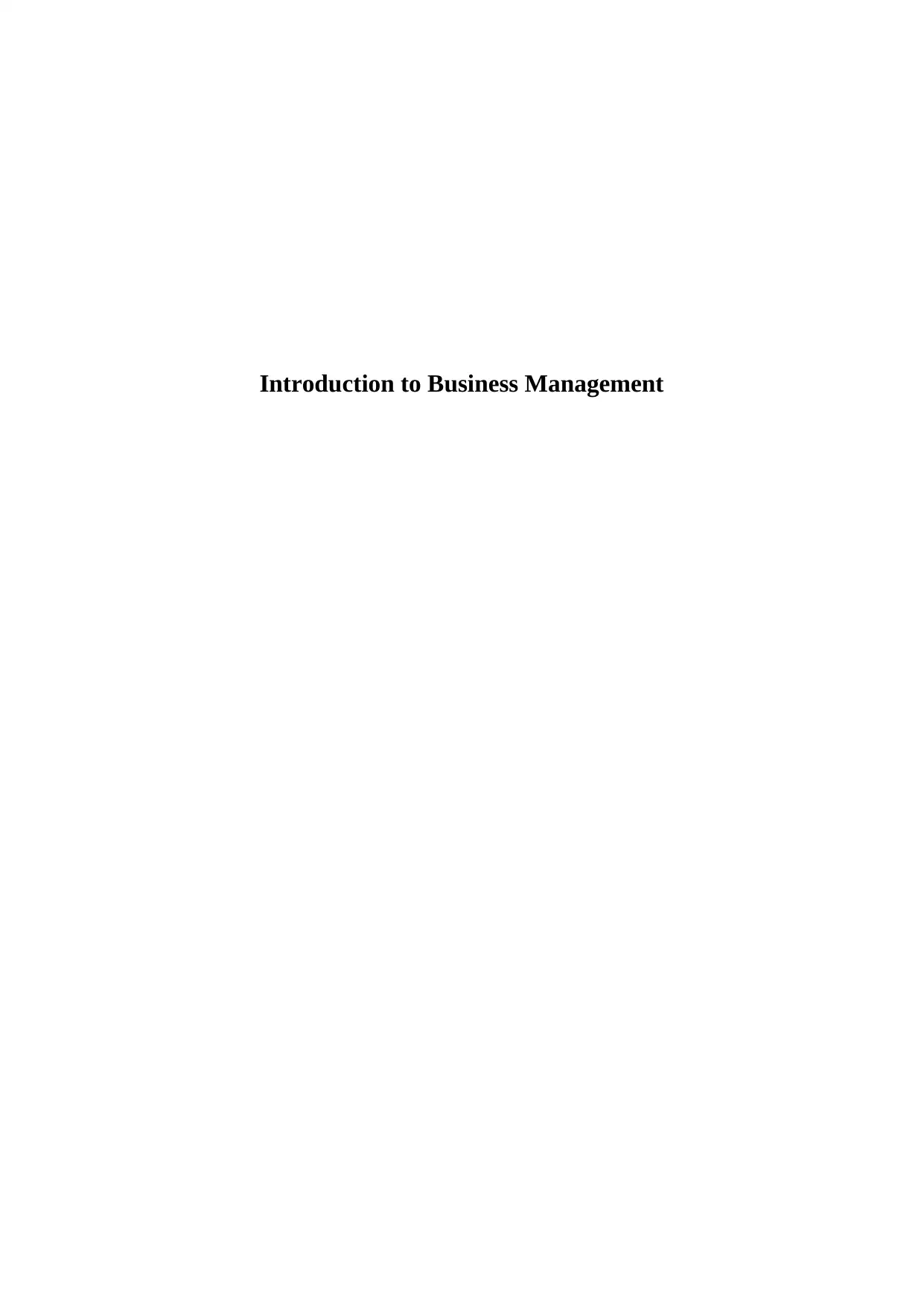
Introduction to Business Management
Paraphrase This Document
Need a fresh take? Get an instant paraphrase of this document with our AI Paraphraser
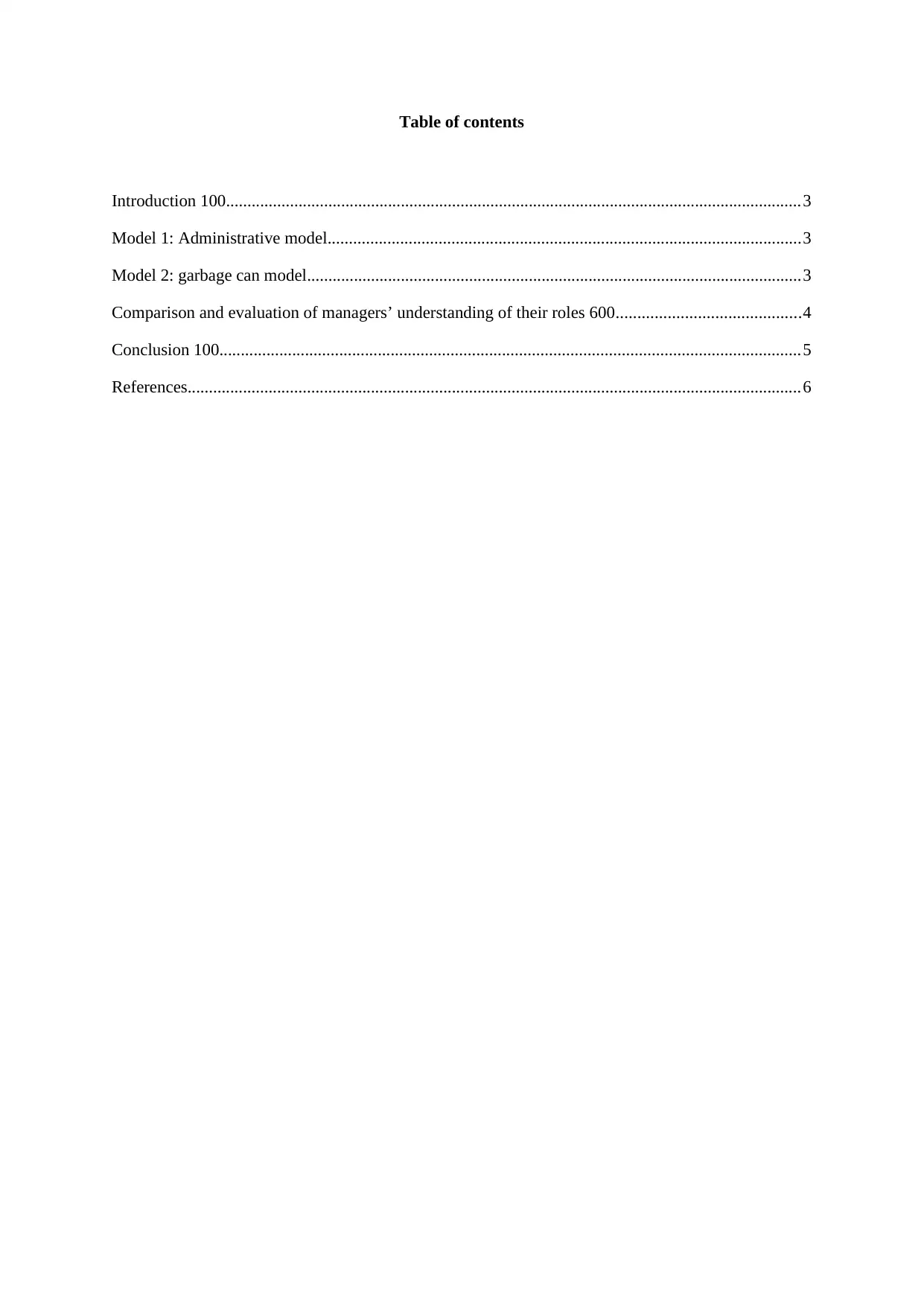
Table of contents
Introduction 100.......................................................................................................................................3
Model 1: Administrative model...............................................................................................................3
Model 2: garbage can model....................................................................................................................3
Comparison and evaluation of managers’ understanding of their roles 600...........................................4
Conclusion 100........................................................................................................................................5
References................................................................................................................................................6
Introduction 100.......................................................................................................................................3
Model 1: Administrative model...............................................................................................................3
Model 2: garbage can model....................................................................................................................3
Comparison and evaluation of managers’ understanding of their roles 600...........................................4
Conclusion 100........................................................................................................................................5
References................................................................................................................................................6
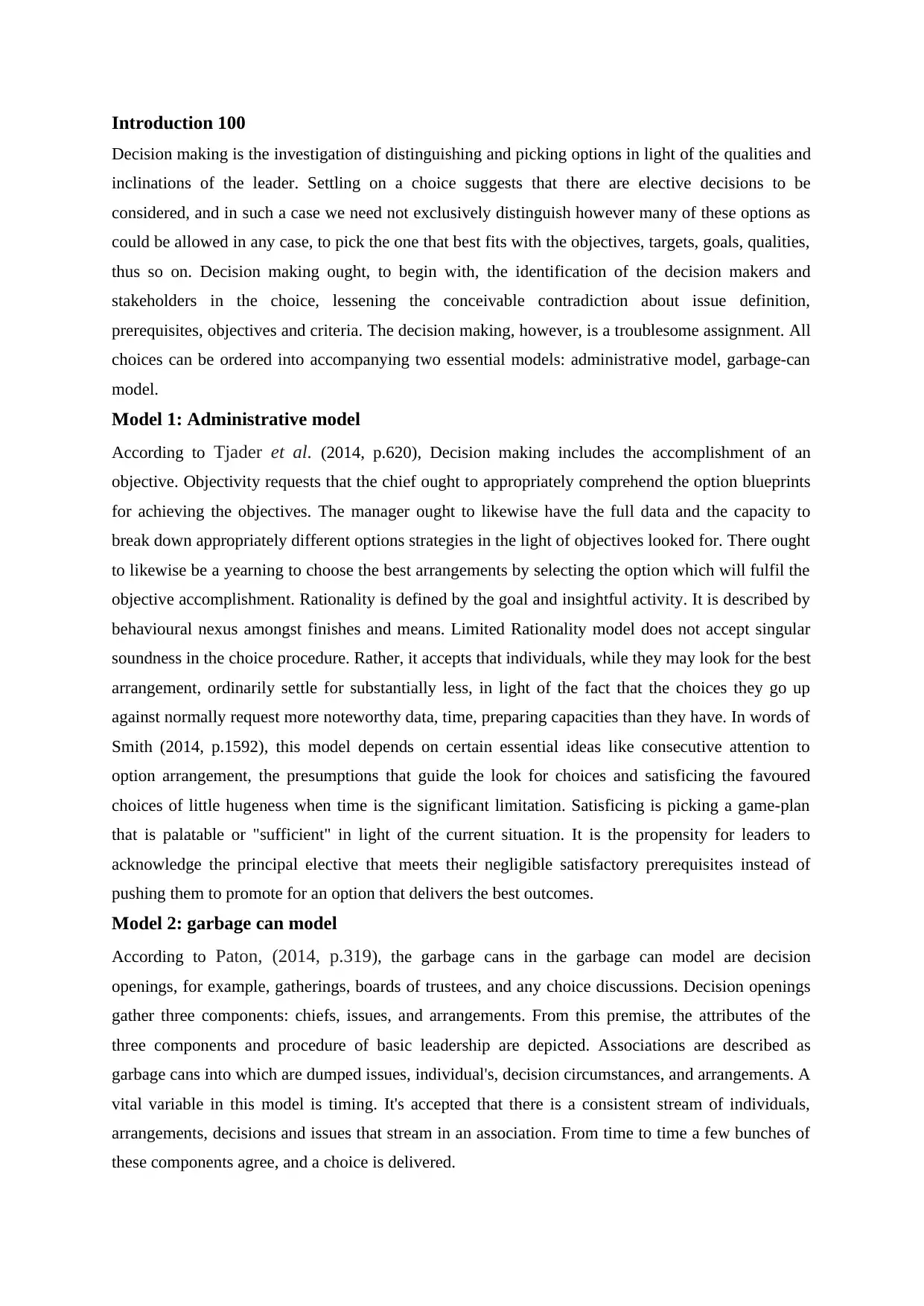
Introduction 100
Decision making is the investigation of distinguishing and picking options in light of the qualities and
inclinations of the leader. Settling on a choice suggests that there are elective decisions to be
considered, and in such a case we need not exclusively distinguish however many of these options as
could be allowed in any case, to pick the one that best fits with the objectives, targets, goals, qualities,
thus so on. Decision making ought, to begin with, the identification of the decision makers and
stakeholders in the choice, lessening the conceivable contradiction about issue definition,
prerequisites, objectives and criteria. The decision making, however, is a troublesome assignment. All
choices can be ordered into accompanying two essential models: administrative model, garbage-can
model.
Model 1: Administrative model
According to Tjader et al. (2014, p.620), Decision making includes the accomplishment of an
objective. Objectivity requests that the chief ought to appropriately comprehend the option blueprints
for achieving the objectives. The manager ought to likewise have the full data and the capacity to
break down appropriately different options strategies in the light of objectives looked for. There ought
to likewise be a yearning to choose the best arrangements by selecting the option which will fulfil the
objective accomplishment. Rationality is defined by the goal and insightful activity. It is described by
behavioural nexus amongst finishes and means. Limited Rationality model does not accept singular
soundness in the choice procedure. Rather, it accepts that individuals, while they may look for the best
arrangement, ordinarily settle for substantially less, in light of the fact that the choices they go up
against normally request more noteworthy data, time, preparing capacities than they have. In words of
Smith (2014, p.1592), this model depends on certain essential ideas like consecutive attention to
option arrangement, the presumptions that guide the look for choices and satisficing the favoured
choices of little hugeness when time is the significant limitation. Satisficing is picking a game-plan
that is palatable or "sufficient" in light of the current situation. It is the propensity for leaders to
acknowledge the principal elective that meets their negligible satisfactory prerequisites instead of
pushing them to promote for an option that delivers the best outcomes.
Model 2: garbage can model
According to Paton, (2014, p.319), the garbage cans in the garbage can model are decision
openings, for example, gatherings, boards of trustees, and any choice discussions. Decision openings
gather three components: chiefs, issues, and arrangements. From this premise, the attributes of the
three components and procedure of basic leadership are depicted. Associations are described as
garbage cans into which are dumped issues, individual's, decision circumstances, and arrangements. A
vital variable in this model is timing. It's accepted that there is a consistent stream of individuals,
arrangements, decisions and issues that stream in an association. From time to time a few bunches of
these components agree, and a choice is delivered.
Decision making is the investigation of distinguishing and picking options in light of the qualities and
inclinations of the leader. Settling on a choice suggests that there are elective decisions to be
considered, and in such a case we need not exclusively distinguish however many of these options as
could be allowed in any case, to pick the one that best fits with the objectives, targets, goals, qualities,
thus so on. Decision making ought, to begin with, the identification of the decision makers and
stakeholders in the choice, lessening the conceivable contradiction about issue definition,
prerequisites, objectives and criteria. The decision making, however, is a troublesome assignment. All
choices can be ordered into accompanying two essential models: administrative model, garbage-can
model.
Model 1: Administrative model
According to Tjader et al. (2014, p.620), Decision making includes the accomplishment of an
objective. Objectivity requests that the chief ought to appropriately comprehend the option blueprints
for achieving the objectives. The manager ought to likewise have the full data and the capacity to
break down appropriately different options strategies in the light of objectives looked for. There ought
to likewise be a yearning to choose the best arrangements by selecting the option which will fulfil the
objective accomplishment. Rationality is defined by the goal and insightful activity. It is described by
behavioural nexus amongst finishes and means. Limited Rationality model does not accept singular
soundness in the choice procedure. Rather, it accepts that individuals, while they may look for the best
arrangement, ordinarily settle for substantially less, in light of the fact that the choices they go up
against normally request more noteworthy data, time, preparing capacities than they have. In words of
Smith (2014, p.1592), this model depends on certain essential ideas like consecutive attention to
option arrangement, the presumptions that guide the look for choices and satisficing the favoured
choices of little hugeness when time is the significant limitation. Satisficing is picking a game-plan
that is palatable or "sufficient" in light of the current situation. It is the propensity for leaders to
acknowledge the principal elective that meets their negligible satisfactory prerequisites instead of
pushing them to promote for an option that delivers the best outcomes.
Model 2: garbage can model
According to Paton, (2014, p.319), the garbage cans in the garbage can model are decision
openings, for example, gatherings, boards of trustees, and any choice discussions. Decision openings
gather three components: chiefs, issues, and arrangements. From this premise, the attributes of the
three components and procedure of basic leadership are depicted. Associations are described as
garbage cans into which are dumped issues, individual's, decision circumstances, and arrangements. A
vital variable in this model is timing. It's accepted that there is a consistent stream of individuals,
arrangements, decisions and issues that stream in an association. From time to time a few bunches of
these components agree, and a choice is delivered.
⊘ This is a preview!⊘
Do you want full access?
Subscribe today to unlock all pages.

Trusted by 1+ million students worldwide
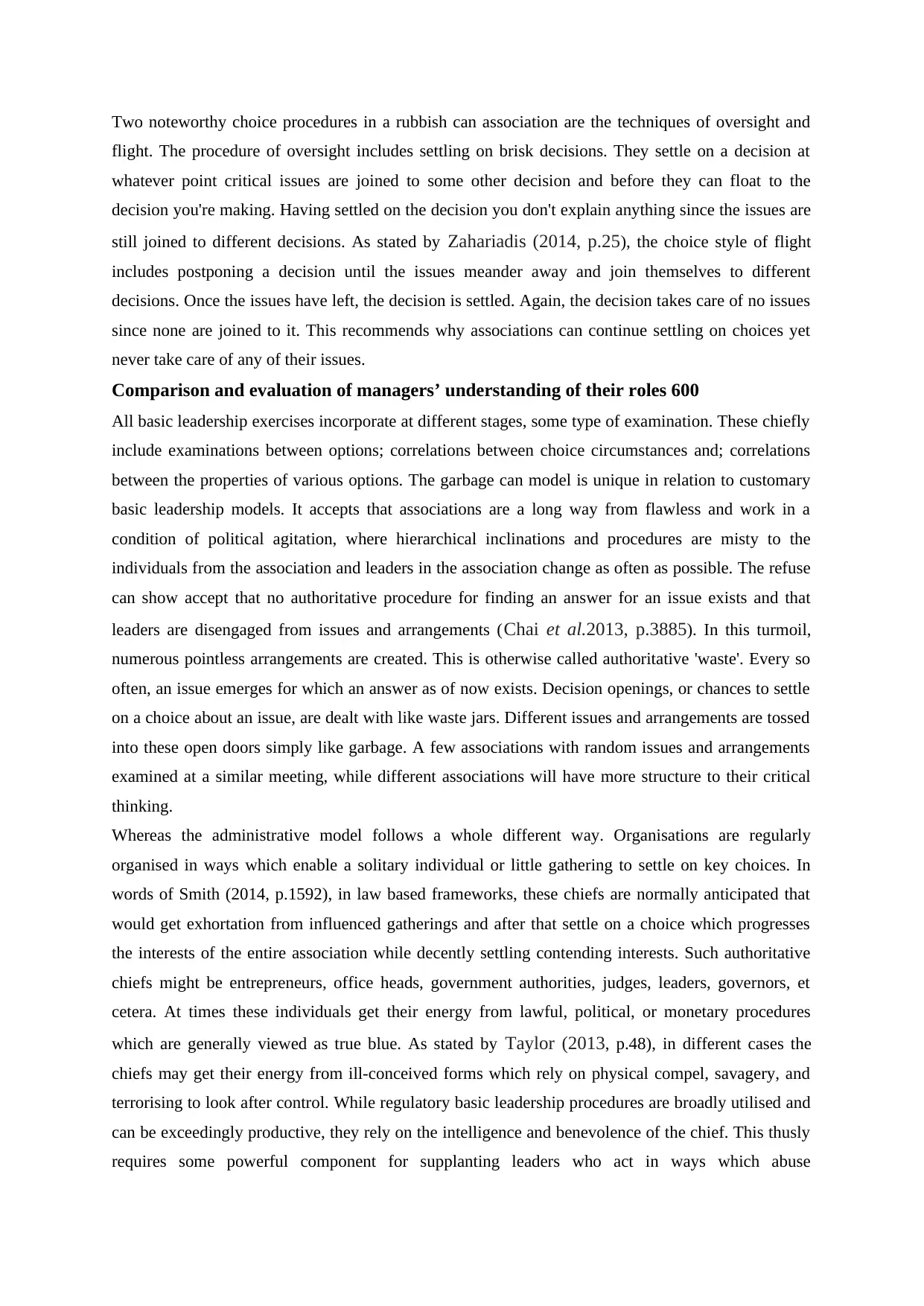
Two noteworthy choice procedures in a rubbish can association are the techniques of oversight and
flight. The procedure of oversight includes settling on brisk decisions. They settle on a decision at
whatever point critical issues are joined to some other decision and before they can float to the
decision you're making. Having settled on the decision you don't explain anything since the issues are
still joined to different decisions. As stated by Zahariadis (2014, p.25), the choice style of flight
includes postponing a decision until the issues meander away and join themselves to different
decisions. Once the issues have left, the decision is settled. Again, the decision takes care of no issues
since none are joined to it. This recommends why associations can continue settling on choices yet
never take care of any of their issues.
Comparison and evaluation of managers’ understanding of their roles 600
All basic leadership exercises incorporate at different stages, some type of examination. These chiefly
include examinations between options; correlations between choice circumstances and; correlations
between the properties of various options. The garbage can model is unique in relation to customary
basic leadership models. It accepts that associations are a long way from flawless and work in a
condition of political agitation, where hierarchical inclinations and procedures are misty to the
individuals from the association and leaders in the association change as often as possible. The refuse
can show accept that no authoritative procedure for finding an answer for an issue exists and that
leaders are disengaged from issues and arrangements (Chai et al.2013, p.3885). In this turmoil,
numerous pointless arrangements are created. This is otherwise called authoritative 'waste'. Every so
often, an issue emerges for which an answer as of now exists. Decision openings, or chances to settle
on a choice about an issue, are dealt with like waste jars. Different issues and arrangements are tossed
into these open doors simply like garbage. A few associations with random issues and arrangements
examined at a similar meeting, while different associations will have more structure to their critical
thinking.
Whereas the administrative model follows a whole different way. Organisations are regularly
organised in ways which enable a solitary individual or little gathering to settle on key choices. In
words of Smith (2014, p.1592), in law based frameworks, these chiefs are normally anticipated that
would get exhortation from influenced gatherings and after that settle on a choice which progresses
the interests of the entire association while decently settling contending interests. Such authoritative
chiefs might be entrepreneurs, office heads, government authorities, judges, leaders, governors, et
cetera. At times these individuals get their energy from lawful, political, or monetary procedures
which are generally viewed as true blue. As stated by Taylor (2013, p.48), in different cases the
chiefs may get their energy from ill-conceived forms which rely on physical compel, savagery, and
terrorising to look after control. While regulatory basic leadership procedures are broadly utilised and
can be exceedingly productive, they rely on the intelligence and benevolence of the chief. This thusly
requires some powerful component for supplanting leaders who act in ways which abuse
flight. The procedure of oversight includes settling on brisk decisions. They settle on a decision at
whatever point critical issues are joined to some other decision and before they can float to the
decision you're making. Having settled on the decision you don't explain anything since the issues are
still joined to different decisions. As stated by Zahariadis (2014, p.25), the choice style of flight
includes postponing a decision until the issues meander away and join themselves to different
decisions. Once the issues have left, the decision is settled. Again, the decision takes care of no issues
since none are joined to it. This recommends why associations can continue settling on choices yet
never take care of any of their issues.
Comparison and evaluation of managers’ understanding of their roles 600
All basic leadership exercises incorporate at different stages, some type of examination. These chiefly
include examinations between options; correlations between choice circumstances and; correlations
between the properties of various options. The garbage can model is unique in relation to customary
basic leadership models. It accepts that associations are a long way from flawless and work in a
condition of political agitation, where hierarchical inclinations and procedures are misty to the
individuals from the association and leaders in the association change as often as possible. The refuse
can show accept that no authoritative procedure for finding an answer for an issue exists and that
leaders are disengaged from issues and arrangements (Chai et al.2013, p.3885). In this turmoil,
numerous pointless arrangements are created. This is otherwise called authoritative 'waste'. Every so
often, an issue emerges for which an answer as of now exists. Decision openings, or chances to settle
on a choice about an issue, are dealt with like waste jars. Different issues and arrangements are tossed
into these open doors simply like garbage. A few associations with random issues and arrangements
examined at a similar meeting, while different associations will have more structure to their critical
thinking.
Whereas the administrative model follows a whole different way. Organisations are regularly
organised in ways which enable a solitary individual or little gathering to settle on key choices. In
words of Smith (2014, p.1592), in law based frameworks, these chiefs are normally anticipated that
would get exhortation from influenced gatherings and after that settle on a choice which progresses
the interests of the entire association while decently settling contending interests. Such authoritative
chiefs might be entrepreneurs, office heads, government authorities, judges, leaders, governors, et
cetera. At times these individuals get their energy from lawful, political, or monetary procedures
which are generally viewed as true blue. As stated by Taylor (2013, p.48), in different cases the
chiefs may get their energy from ill-conceived forms which rely on physical compel, savagery, and
terrorising to look after control. While regulatory basic leadership procedures are broadly utilised and
can be exceedingly productive, they rely on the intelligence and benevolence of the chief. This thusly
requires some powerful component for supplanting leaders who act in ways which abuse
Paraphrase This Document
Need a fresh take? Get an instant paraphrase of this document with our AI Paraphraser
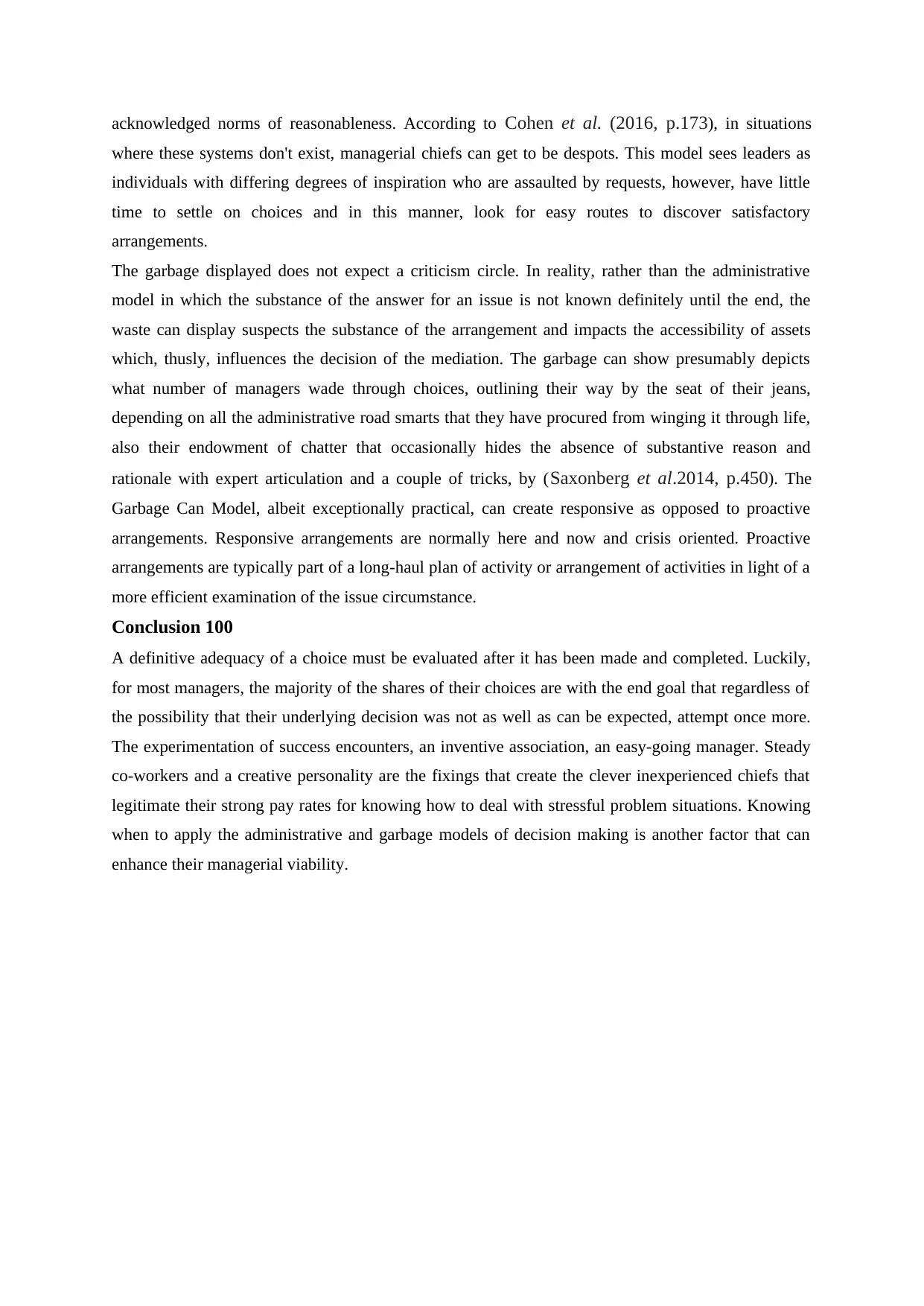
acknowledged norms of reasonableness. According to Cohen et al. (2016, p.173), in situations
where these systems don't exist, managerial chiefs can get to be despots. This model sees leaders as
individuals with differing degrees of inspiration who are assaulted by requests, however, have little
time to settle on choices and in this manner, look for easy routes to discover satisfactory
arrangements.
The garbage displayed does not expect a criticism circle. In reality, rather than the administrative
model in which the substance of the answer for an issue is not known definitely until the end, the
waste can display suspects the substance of the arrangement and impacts the accessibility of assets
which, thusly, influences the decision of the mediation. The garbage can show presumably depicts
what number of managers wade through choices, outlining their way by the seat of their jeans,
depending on all the administrative road smarts that they have procured from winging it through life,
also their endowment of chatter that occasionally hides the absence of substantive reason and
rationale with expert articulation and a couple of tricks, by (Saxonberg et al.2014, p.450). The
Garbage Can Model, albeit exceptionally practical, can create responsive as opposed to proactive
arrangements. Responsive arrangements are normally here and now and crisis oriented. Proactive
arrangements are typically part of a long-haul plan of activity or arrangement of activities in light of a
more efficient examination of the issue circumstance.
Conclusion 100
A definitive adequacy of a choice must be evaluated after it has been made and completed. Luckily,
for most managers, the majority of the shares of their choices are with the end goal that regardless of
the possibility that their underlying decision was not as well as can be expected, attempt once more.
The experimentation of success encounters, an inventive association, an easy-going manager. Steady
co-workers and a creative personality are the fixings that create the clever inexperienced chiefs that
legitimate their strong pay rates for knowing how to deal with stressful problem situations. Knowing
when to apply the administrative and garbage models of decision making is another factor that can
enhance their managerial viability.
where these systems don't exist, managerial chiefs can get to be despots. This model sees leaders as
individuals with differing degrees of inspiration who are assaulted by requests, however, have little
time to settle on choices and in this manner, look for easy routes to discover satisfactory
arrangements.
The garbage displayed does not expect a criticism circle. In reality, rather than the administrative
model in which the substance of the answer for an issue is not known definitely until the end, the
waste can display suspects the substance of the arrangement and impacts the accessibility of assets
which, thusly, influences the decision of the mediation. The garbage can show presumably depicts
what number of managers wade through choices, outlining their way by the seat of their jeans,
depending on all the administrative road smarts that they have procured from winging it through life,
also their endowment of chatter that occasionally hides the absence of substantive reason and
rationale with expert articulation and a couple of tricks, by (Saxonberg et al.2014, p.450). The
Garbage Can Model, albeit exceptionally practical, can create responsive as opposed to proactive
arrangements. Responsive arrangements are normally here and now and crisis oriented. Proactive
arrangements are typically part of a long-haul plan of activity or arrangement of activities in light of a
more efficient examination of the issue circumstance.
Conclusion 100
A definitive adequacy of a choice must be evaluated after it has been made and completed. Luckily,
for most managers, the majority of the shares of their choices are with the end goal that regardless of
the possibility that their underlying decision was not as well as can be expected, attempt once more.
The experimentation of success encounters, an inventive association, an easy-going manager. Steady
co-workers and a creative personality are the fixings that create the clever inexperienced chiefs that
legitimate their strong pay rates for knowing how to deal with stressful problem situations. Knowing
when to apply the administrative and garbage models of decision making is another factor that can
enhance their managerial viability.
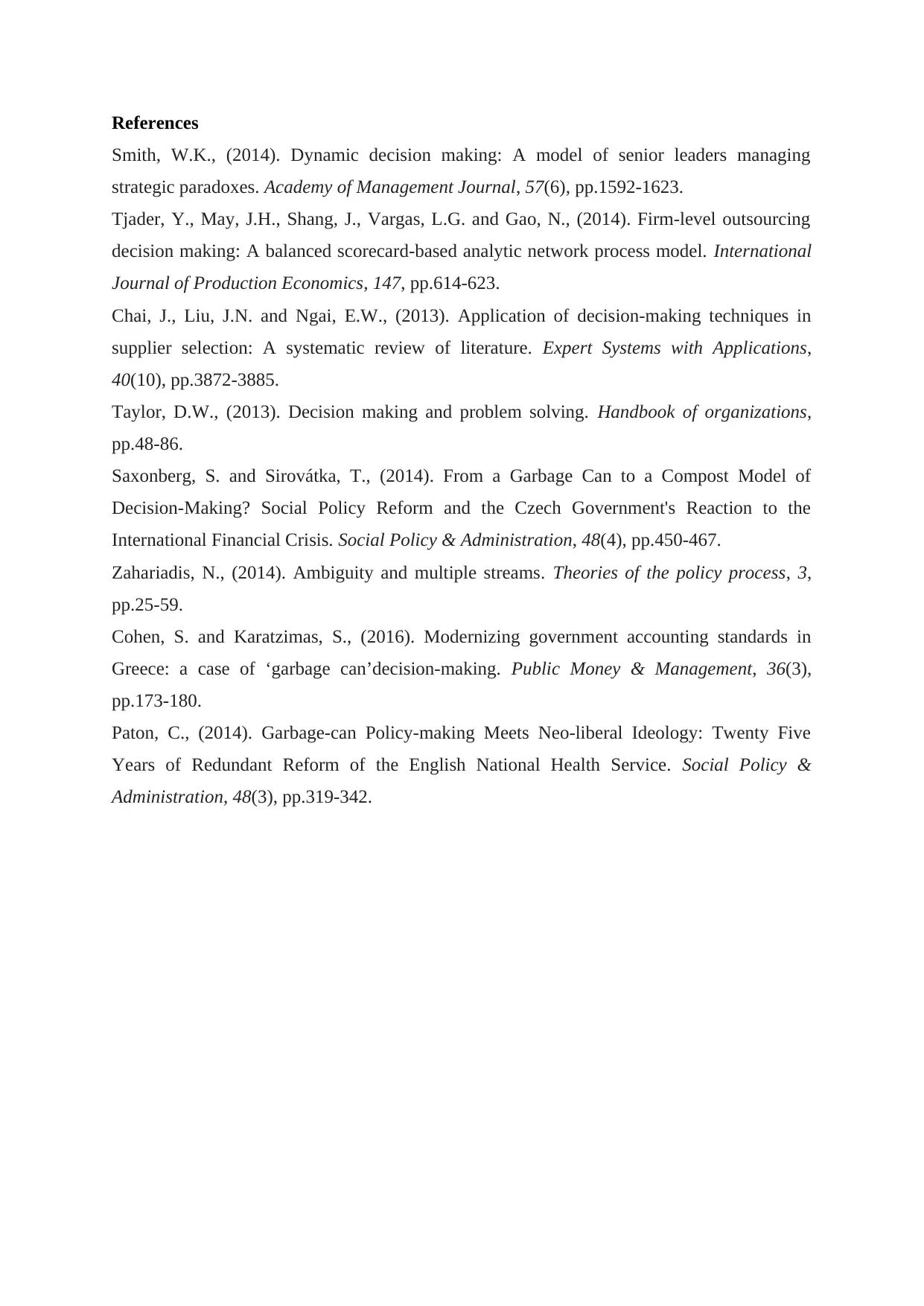
References
Smith, W.K., (2014). Dynamic decision making: A model of senior leaders managing
strategic paradoxes. Academy of Management Journal, 57(6), pp.1592-1623.
Tjader, Y., May, J.H., Shang, J., Vargas, L.G. and Gao, N., (2014). Firm-level outsourcing
decision making: A balanced scorecard-based analytic network process model. International
Journal of Production Economics, 147, pp.614-623.
Chai, J., Liu, J.N. and Ngai, E.W., (2013). Application of decision-making techniques in
supplier selection: A systematic review of literature. Expert Systems with Applications,
40(10), pp.3872-3885.
Taylor, D.W., (2013). Decision making and problem solving. Handbook of organizations,
pp.48-86.
Saxonberg, S. and Sirovátka, T., (2014). From a Garbage Can to a Compost Model of
Decision‐Making? Social Policy Reform and the Czech Government's Reaction to the
International Financial Crisis. Social Policy & Administration, 48(4), pp.450-467.
Zahariadis, N., (2014). Ambiguity and multiple streams. Theories of the policy process, 3,
pp.25-59.
Cohen, S. and Karatzimas, S., (2016). Modernizing government accounting standards in
Greece: a case of ‘garbage can’decision-making. Public Money & Management, 36(3),
pp.173-180.
Paton, C., (2014). Garbage‐can Policy‐making Meets Neo‐liberal Ideology: Twenty Five
Years of Redundant Reform of the English National Health Service. Social Policy &
Administration, 48(3), pp.319-342.
Smith, W.K., (2014). Dynamic decision making: A model of senior leaders managing
strategic paradoxes. Academy of Management Journal, 57(6), pp.1592-1623.
Tjader, Y., May, J.H., Shang, J., Vargas, L.G. and Gao, N., (2014). Firm-level outsourcing
decision making: A balanced scorecard-based analytic network process model. International
Journal of Production Economics, 147, pp.614-623.
Chai, J., Liu, J.N. and Ngai, E.W., (2013). Application of decision-making techniques in
supplier selection: A systematic review of literature. Expert Systems with Applications,
40(10), pp.3872-3885.
Taylor, D.W., (2013). Decision making and problem solving. Handbook of organizations,
pp.48-86.
Saxonberg, S. and Sirovátka, T., (2014). From a Garbage Can to a Compost Model of
Decision‐Making? Social Policy Reform and the Czech Government's Reaction to the
International Financial Crisis. Social Policy & Administration, 48(4), pp.450-467.
Zahariadis, N., (2014). Ambiguity and multiple streams. Theories of the policy process, 3,
pp.25-59.
Cohen, S. and Karatzimas, S., (2016). Modernizing government accounting standards in
Greece: a case of ‘garbage can’decision-making. Public Money & Management, 36(3),
pp.173-180.
Paton, C., (2014). Garbage‐can Policy‐making Meets Neo‐liberal Ideology: Twenty Five
Years of Redundant Reform of the English National Health Service. Social Policy &
Administration, 48(3), pp.319-342.
⊘ This is a preview!⊘
Do you want full access?
Subscribe today to unlock all pages.

Trusted by 1+ million students worldwide
1 out of 6
Your All-in-One AI-Powered Toolkit for Academic Success.
+13062052269
info@desklib.com
Available 24*7 on WhatsApp / Email
![[object Object]](/_next/static/media/star-bottom.7253800d.svg)
Unlock your academic potential
Copyright © 2020–2025 A2Z Services. All Rights Reserved. Developed and managed by ZUCOL.
